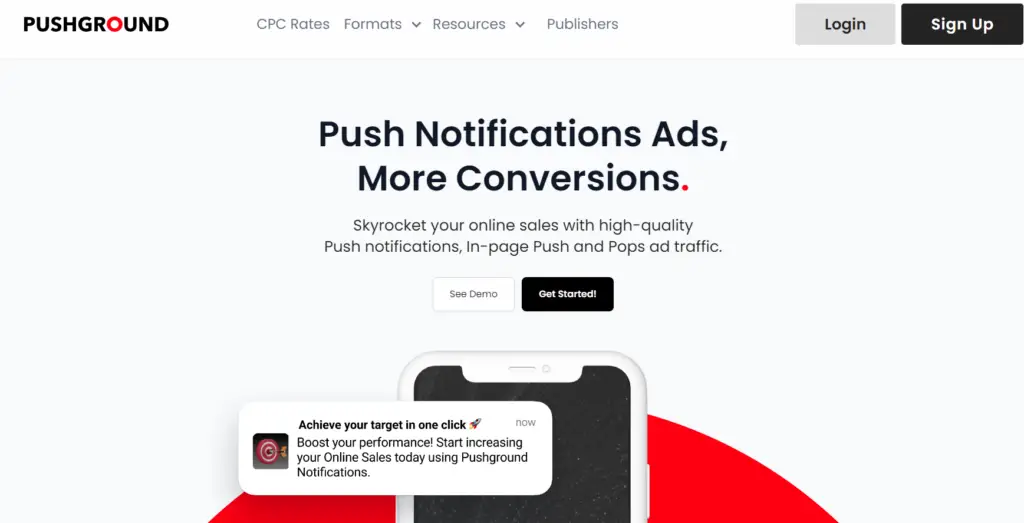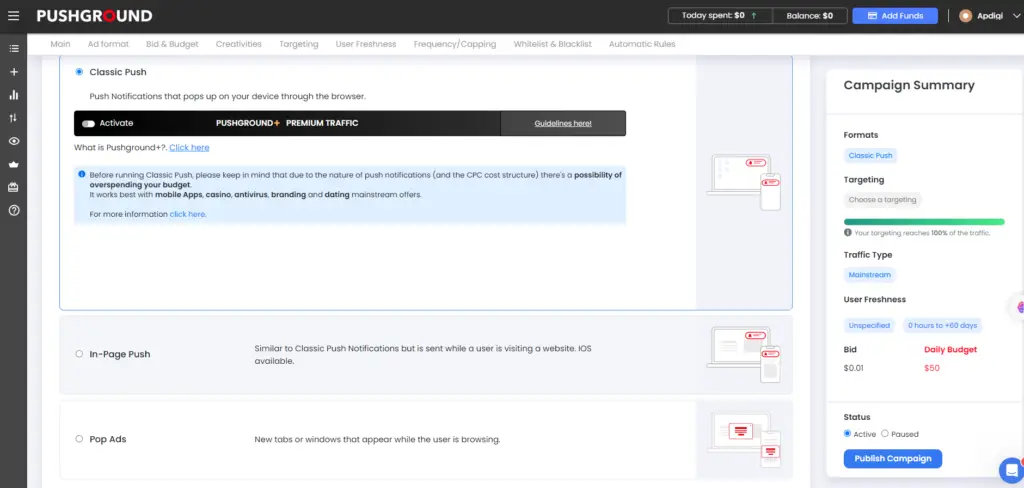Push notifications are everywhere, but with so many options, is PushGround a real contender or just another empty promise? We’re diving deep to uncover the truth in this PushGround Review: Hype or Hidden Gem?
We’ll dissect everything that matters to you, from features and pricing to how effective PushGround is. Are you getting the best bang for your buck, or are hidden drawbacks lurking? Whether you’re an advertiser or a publisher, this review will equip you with the knowledge you need to decide: Is PushGround the secret weapon your marketing strategy craves, or just another notification lost in the noise?
What is PushGround?

PushGround is a self-service advertising network specializing in push notifications. It allows advertisers to reach a global audience through targeted push ads delivered directly to users’ devices. It also used to offer POP Ads. It has very high-quality Human Traffic as “Pushground is fully integrated with Opticks Security’s anti-fraud solution to prevent any fraudulent or bot traffic and ensure the integrity of your campaigns”.
Here’s a breakdown of PushGround’s key features:
- Push Ads: These are pop-up notifications that appear on desktops and mobile devices, even when users aren’t actively using the app or website that sent them. PushGround offers both classic push notifications and in-page push ads.
- Global Reach: With over a billion daily impressions, PushGround boasts a massive network that can extend your marketing reach worldwide.
- Cost-Effective Pricing: They operate on a CPC (cost per click) model, so you only pay when users engage with your ads by clicking on them.
- Performance Optimization: PushGround utilizes advanced algorithms and allows A/B testing to help you optimize your campaigns for maximum effectiveness.
- Fraud Protection: Their integration with anti-fraud solutions helps ensure you’re not paying for bot traffic or invalid clicks.
In essence, PushGround provides a platform for advertisers to leverage push notifications as a marketing tool to reach a large audience and drive user engagement.
How To Integrate PushGround with The Website?
Integrating PushGround with your website is a straightforward process that can be completed in a few simple steps:
- Sign up for a PushGround account and get approved as a publisher.
- Create your ad zones in the PushGround dashboard by specifying the size and location of your ad units on your website.
- Copy the ad zone code provided by PushGround and paste it into the HTML code of your website where you want the ads to appear.
- PushGround will then start serving ads to your website visitors, and you will earn revenue based on the number of impressions or clicks generated by the ads.
Done, you just integrated your website into PushGround as a publisher.
Things To Read:
- CPAGrip Review: Is it worth it? – (Inside Out View)
- TrafficJunky Review: How to Make Thousands Per Month With TrafficJunky
- PropellerAds Review: Propelling Your Business to New Heights
- Bongacash Review: Unveiling the Pros and Cons of this Affiliate Program!
- Discover the Truth About Adxxx: An Honest Adxxx Review
Ad Formats of PushGround

PushGround is used To offer three ad Formats i.e. Classic Push, In-Page Push, and Pop Ads with two types of audiences “Pushground+ and Casual”. PushGround+ is a premium Ad Category while the second one is the regular one. Getting Approved with PushGround+ is tough as it has too many rules and regulations.
Here is my experience with the BOT traffic of PUSHGround.
| Ad Format | Total Traffic Acquired | Bot Traffic |
|---|---|---|
| Classic Push | .8 Million | 5% |
| In-Page Push | .4 Million+ | 7% |
| Pop-Under Ads | 1.5 Million+ | 6% |
Requirements:
To become a publisher or advertiser with PushGround, there are certain requirements you must meet:
For publishers:
- Your website must have original content and be fully functional
- Your website must comply with PushGround’s content guidelines
- You must have a valid PayPal account to receive payments
For advertisers:
- You must have a valid business or individual account
- You must have a valid payment method to fund your campaigns
- Your ad creatives must comply with PushGround’s ad guidelines
- Your campaigns must meet the minimum bid requirements for the ad format you choose
These are the some basic requirements, they may ask you to follow before getting a part of the ad network.
Earning Potential:
Publisher as well as advertisers at PushGround has two take away in terms of earning potential. Let us take a deep dive:
Publisher:
PushGround uses a revenue share model(60% to the Publishers), where publishers receive a percentage of the revenue generated by the ads displayed on their website. The exact revenue share percentage may vary depending on your traffic volume and the ad format you choose.
PushGround pays its publishers on a net 30 basis, which means you’ll receive payment for your earnings 30 days after the end of each calendar month. Payments can be made through PayPal or wire transfer, and there is a minimum payout threshold of $100.
To maximize your earnings with PushGround, optimising your ad placements, using high-quality ad creatives, and driving high-quality traffic to your website are important. PushGround provides optimization tools and resources to help you get the most out of your advertising campaigns and increase your revenue.
Advertisers:
As an advertiser with PushGround, you can reach a wide audience and promote your products or services through various ad formats, including display, native, video, and pop-under ads. The platform offers advanced targeting options, such as geo-targeting, device targeting, and browser targeting, to help you reach your desired audience and maximize your ad spend.
The product I promoted as Advertiser PushGround:
In this section of the review, I am going to share the products, I promoted with the help of PushGround in different Geos. Here’s the facts:
| Offer | Geos | Amount spend | ROI | For Whom |
|---|---|---|---|---|
| Antivirus | UK | 2000$ | 420% | Surfshark |
| Antivirus | USA | 2000$ | 352% | Avast |
| Antivirus | India | 1000$ | 624% | Norton |
| Earning App | India | 1000$ | 152% | Myself |
| Traffic Arbitrage | India | 2200$ | 89% | Myself |
| Traffic Arbitrage | Europe | 1500$ | 368% | Myself |
| Traffic Arbitrage | USA | 15000$ | 74% | Myself |
Pros and Cons: PushGround Review
PushGround is a relatively new player in the push notification ad network scene, but it offers some interesting features. Here’s a breakdown of its pros and cons to help you decide if it’s right for you:
Pros:
- Cost-Effective Pricing: PushGround offers a few pricing models, including cost-per-click (CPC) which allows advertisers to only pay when users click on the ad. This can be a budget-friendly option for campaigns with high delivery volumes.
- Highly Targeted Ads: PushGround allows for targeted and personalized ad campaigns, increasing the chances of user engagement.
- Large Reach: PushGround boasts a significant subscriber base, allowing advertisers to reach a wide audience.
- Anti-Fraud Measures: Like many ad networks, PushGround claims to have anti-fraud solutions in place to protect users and advertisers from invalid clicks.
Cons:
- Relatively New: Being a newer platform, PushGround might not have the same level of established track record compared to more well-known competitors.
- Limited Traffic for Certain Verticals: PushGround restricts adult content, which might be a limitation for advertisers in that vertical.
- Scaling Issues: There have been reports of challenges in scaling campaigns in some countries.
Extras To Read:
- TrafficStars Review: A Deep Dive into the Ad Network’s Features and Performance
- PropellerAds Review: Propelling Your Business to New Heights
- (60+) Unlocking Revenue: Top Ad Networks for Publishers
Overall:
PushGround has the potential to be a valuable tool for advertisers and publishers, especially with its cost-effective pricing and targeting options. However, its relative newness and limitations in specific areas are worth considering. It might be a good idea to test PushGround alongside other established networks to see which one performs best for your needs.
